Talking Dolls: The New Wave Look and Language of Female Subjectivity
Abstract
Agnès Varda, Jean-Luc Godard, and Francois Truffaut are three founding filmmakers of the French New Wave, and the films Cléo de 5 à 7 (1962), Le mépris (1963), and L’histoire d’Adèle H. (1975) are exemplary of this movement’s cinematic and social aims. Through their female protagonists, the filmmakers represent a changing relation of women to the look of the spectator, cinema, and self, and consequently, language and their own subjectivity. One can trace this change in female representation through Godard’s deconstruction of Camille and Varda’s deconstruction of Cléo as fetishized objects, and Varda’s construction of Cléo as a desiring subject who is both self- and socially conscious. In women’s relation to the look and language, Truffaut takes his construction of Adèle one step further, as a desiring creative subject who descends into a poetic madness in her pursuit of a male love-object. All the filmmakers target the cinematic techniques of costuming, lighting and essentially, looking, that create conventional images of women as objects. The rephrasing of the female image indicates that it is control of language that ultimately defines this new female subjectivity.Downloads
Published
2013-04-27
Issue
Section
Articles

